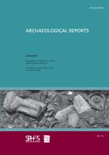
Archaeological Reports-London
Scope & Guideline
Transforming Discoveries into Scholarly Discourse
Introduction
Aims and Scopes
- Roman and Byzantine Archaeology:
The journal emphasizes research on Roman and Byzantine periods, exploring various aspects such as urban development, art, and societal changes in regions like Crete and the Peloponnese. - Greek Art and Architecture:
A significant focus is placed on the study of Greek art and architecture, showcasing recent developments and trends that reflect the evolution of artistic practices and construction techniques. - Environmental and Societal Interactions:
Research examining the interactions between ancient societies and their environments, including climate impacts and adaptation strategies, is a core area of interest. - Material Culture and Technological Advances:
The journal highlights studies related to material culture, including archaeometallurgy and zooarchaeology, which provide insights into ancient production and subsistence practices. - Fieldwork and Research Reviews:
Regular reviews of archaeological fieldwork and research initiatives, especially those conducted by institutions like the British School at Athens, contribute to the journal's commitment to documenting ongoing academic efforts.
Trending and Emerging
- Climate and Environmental Studies:
Recent publications increasingly focus on the intersection of climate, environment, and society, highlighting the importance of understanding how ancient populations adapted to changing environmental conditions. - Shipwreck and Maritime Archaeology:
There is a growing trend towards the study of shipwrecks and maritime archaeology, emphasizing the significance of maritime trade and naval activities in ancient Mediterranean societies. - Zooarchaeological Research:
The rise of zooarchaeological studies indicates a burgeoning interest in understanding ancient diets and animal husbandry practices, contributing to broader discussions on subsistence and economy. - Interdisciplinary Approaches:
An emerging theme involves interdisciplinary methodologies, incorporating techniques from fields such as archaeometry and environmental science to enrich archaeological interpretations.
Declining or Waning
- Palaeolithic Archaeology:
Research on Palaeolithic archaeology has seen a noticeable decline, with fewer recent studies addressing this period, indicating a potential shift in focus towards later historical periods. - Textile Economies:
The exploration of textile economies in ancient Greece is less frequently addressed in recent publications, suggesting a waning interest in this niche area of research compared to broader archaeological themes. - Sanctuaries and Cult Practices:
Although once a prominent theme, recent works on sanctuaries and cult practices from the Roman conquest to Late Antiquity have diminished, possibly overshadowed by more contemporary archaeological issues.
Similar Journals

ARCHAEOLOGY IN OCEANIA
Uncovering the Rich Tapestry of Oceania's PastARCHAEOLOGY IN OCEANIA, published by Wiley, is a leading journal that delves into the rich and diverse archaeological landscape of the Pacific region. With a commitment to advancing knowledge in anthropology and archaeology, this esteemed publication has been pivotal in shaping scholarly discussions since its inception in 1966. Spanning generations of research, it has seen converged years of publication from 1966 to 1980 and from 2002 to 2024. With an impressive Scopus ranking placing it in the top quartiles across multiple categories - including Q2 in Anthropology and Q1 in Archeology (arts and humanities) - the journal distinguishes itself as a must-read for researchers, professionals, and students alike. Although it operates on a subscription model, its rigorous peer-reviewed articles and comprehensive studies contribute significantly to understanding the past of Oceania, making it an essential resource for those invested in this vibrant field of study.

Opuscula-Annual of the Swedish Institutes at Athens and Rome
Elevating Scholarship in Classics, History, and the ArtsOpuscula - Annual of the Swedish Institutes at Athens and Rome is a distinguished academic journal dedicated to advancing the field of archaeology, classics, history, and the visual arts. Published by the Editorial Committee Swedish Institute Athens & Rome, this journal fosters interdisciplinary dialogue and research, contributing valuable scholarship to these interconnected domains. With an impressive impact factor reflected in the authoritative Scopus rankings, it holds a commendable Q2 ranking in Archaeology and Arts and Humanities and achieves Q1 status in Classics, History, and Visual Arts and Performing Arts. Although Open Access options are not specified, the journal remains a critical resource for scholars seeking peer-reviewed articles that cover a range of topics pertinent to the rich legacies of the Mediterranean. By bridging historical inquiry with contemporary analysis, Opuscula serves as an essential platform for researchers, professionals, and students, ensuring the ongoing vitality of academic discourse in these vital fields.
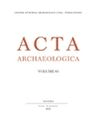
ACTA ARCHAEOLOGICA
Unearthing the Past, Shaping the FutureACTA ARCHAEOLOGICA is a highly regarded, peer-reviewed journal published by BRILL, focusing on the dynamic field of archaeology. With an ISSN of 0065-101X and an E-ISSN of 1600-0390, this journal disseminates innovative research, critical analyses, and comprehensive reviews that contribute to our understanding of human history, cultural heritage, and archaeological methodology. ACTA ARCHAEOLOGICA has excelled in its field, achieving a Q1 ranking in both the Arts and Humanities and Social Sciences categories for 2023, showcasing its impact and relevance in scholarly discourse. Though not currently open access, the journal caters to a diverse audience of researchers, professionals, and students, offering invaluable insights into archaeological studies from a global perspective. As it continues to foster academic dialogue, ACTA ARCHAEOLOGICA remains a cornerstone for those looking to deepen their knowledge and engage with cutting-edge archaeological research.
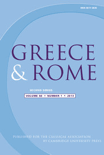
GREECE & ROME
Reviving the Voices of the Ancient WorldGREECE & ROME, published by Cambridge University Press, is a prestigious journal dedicated to the study of classical antiquity and its enduring influence on contemporary culture. This journal, indexed with ISSN 0017-3835 and E-ISSN 1477-4550, offers a platform for scholarly articles that delve into various aspects of Greek and Roman societies, literature, art, and history. With a rich history that spans from 1931 to 2024, it has consistently maintained an important position in the academic community, achieving a Q2 ranking in Classics and a Q3 ranking in Arts and Humanities as of 2023. Highlighted by a Scopus ranking of #74 out of 170 in Classics, the journal appeals to a diverse audience, including researchers, professionals, and students aspiring to deepen their understanding of the classical world. Although it does not offer open access, GREECE & ROME is committed to the dissemination of critical research and thought-provoking discourse, making significant contributions to the fields and encouraging intellectual exchange across disciplines.

Zbornik Radova Vizantoloskog Instituta
Exploring the Rich Tapestry of Byzantine StudiesZbornik Radova Vizantoloskog Instituta is a distinguished open-access journal published by the Institute of Byzantine Studies, Serbian Academy of Sciences and Arts, located in Belgrade, Serbia. Since its inception in 2003, this journal has served as a vital platform for the dissemination of scholarly research in the fields of Classics, History, Linguistics and Language, and Literature and Literary Theory. Although it currently holds a Q4 ranking in the 2023 category quartiles, its commitment to fostering academic discourse and research accessibility is unwavering. The journal features a diverse range of articles that explore the complexities and nuances of Byzantine studies and related disciplines, catering to a broad audience of researchers, professionals, and students dedicated to the humanities. With a focus on both historical context and contemporary perspectives, Zbornik Radova Vizantoloskog Instituta aims to contribute significant insights into the academic community while promoting scholarly interaction on a global scale.

Lucentum
A Beacon of Scholarly ExcellenceLucentum is a distinguished open-access journal published by Universidad de Alicante, focusing on the interdisciplinary fields of Archeology, History, and Paleontology. Since its inception in 1982, it has established itself as a vital platform for scholars and researchers to disseminate their findings, contributing significantly to the academic landscape in Spain and beyond. The journal's notable rankings, including Q1 status in History and Q2 in Archeology, reflect its commitment to high-quality scholarship and rigorous peer review. With an impressive impact factor and recognition in Scopus, Lucentum serves as an essential resource for professionals, students, and historians, fostering a deeper understanding of cultural and historical contexts through a wealth of interdisciplinary research. The journal continues to embrace open access, ensuring that critical knowledge is freely available to the global research community.
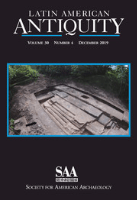
LATIN AMERICAN ANTIQUITY
Illuminating the Past: A Gateway to Latin America's Ancient CivilizationsLATIN AMERICAN ANTIQUITY is a prestigious journal published by Cambridge University Press, focusing on the archaeology and history of Latin America. With an impressive impact factor reflecting its critical role in the academic community, this journal exemplifies excellence in research, landing in Q1 across multiple categories, including Archaeology and History, as per the 2023 category quartiles. The journal's scope covers a broad range of topics related to pre-Columbian cultures, ancient civilizations, and historical developments, making it essential reading for researchers, professionals, and students keen on exploring the rich tapestry of Latin American heritage. Although it is not an open-access publication, LATIN AMERICAN ANTIQUITY remains a vital resource for those dedicated to advancing knowledge in this dynamic field. With its commitment to scholarly rigor and a strong ranking in Scopus, it serves as a cornerstone for academic dialogue and investigation.

Adalya
Exploring the Depths of Mediterranean HeritageAdalya, published by the esteemed Koc University Suna & Inan Kirac Research Center for Mediterranean Civilizations (AKMED), is a prominent academic journal dedicated to the fields of Archeology, History, and Conservation. With an ISSN of 1301-2746, this journal serves as an essential platform for scholars and researchers, fostering insightful discussions and disseminating significant findings about Mediterranean civilizations. Recognized in the quartile rankings of Q3 in Archeology and Q2 in both Conservation and History for the year 2023, Adalya reflects an impactful presence in its respective disciplines. Although it operates under a traditional subscription model, the journal remains accessible to a diverse audience interested in the nuanced exploration of historical contexts and conservation practices. Located in Antalya, Turkey, the journal has carved out a niche since its inception in 2009, bridging the past and present through rigorous academic inquiry. Whether you are a seasoned researcher or a student eager to deepen your understanding of Mediterranean cultures, Adalya offers invaluable resources and perspectives that enrich the academic community.
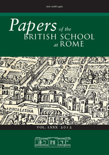
Papers of the British School at Rome
Elevating Academic Discourse on Rome's Timeless InfluencePapers of the British School at Rome, published by Cambridge University Press, is a prestigious journal that has been contributing to the fields of archaeology, history, and visual arts since its inception in 1902. With an ISSN of 0068-2462 and an E-ISSN of 2045-239X, this journal serves as an essential platform for innovative research and scholarly dialogue that explores the rich cultural heritage of Rome and its surrounding areas. The journal is ranked in the top quartiles for various categories, including Q1 in Visual Arts and Performing Arts, reflecting its significant impact and relevance in these fields. Despite its non-open access status, the journal boasts a robust readership, comprising researchers, professionals, and students eager to delve into the scholarly discussions it fosters. The Scopus rankings further affirm its reputation, with high percentiles in key areas, marking it as a vital resource for anyone invested in the academic study of classical and contemporary Roman culture. The journal's objective is to promote interdisciplinary research, making it a cornerstone for advancements in art history and archaeological studies.
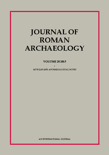
Journal of Roman Archaeology
Preserving the Past: Critical Analyses of Archaeological PracticesJournal of Roman Archaeology is a premier academic journal published by CAMBRIDGE UNIVERSITY PRESS, dedicated to advancing knowledge in the fields of archaeology, classics, and visual arts. With its established reputation since 2005, the journal occupies a significant place in the scholarly community, featured in the Q1 quartile in both Classics and Visual Arts & Performing Arts categories, as well as Q2 and Q3 in Archaeology, reflecting its high impact and relevance. The journal not only presents rigorous research but also fosters interdisciplinary dialogue among researchers, professionals, and students across related fields. Although it does not operate under an open access model, it provides essential insights and critical analyses that contribute to understanding Roman archaeological practices and artifacts. With an ISSN of 1047-7594 and an E-ISSN of 2331-5709, the Journal of Roman Archaeology is an indispensable resource for anyone engaged in the exploration of ancient cultures, heritage preservation, and archaeological methodologies.